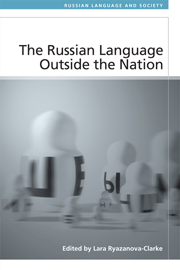Book contents
- Frontmatter
- Contents
- Notes on Contributors
- Cyrillic Transliteration System Adopted in the Book
- Introduction: The Russian Language, Challenged by Globalisation
- PART I Russian and Its Legal Status
- PART II Linguistic Perceptions and Symbolic Values
- PART III Russian-Speaking Communities and Identity Negotiations
- 5 Post-Soviet Russian-Speaking Diaspora in Italy: Results of a Sociolinguistic Survey
- 6 Ethnolinguistic Vitality and Acculturation Orientations of Russian Speakers in Estonia
- 7 Linguistic Performance of Russianness among Russian-Israeli Parents: Child-Raising Practices in the Immigrant Community
- PART IV Language Contact and the Globalisation of Russian
- PART V Globalisation of Russian as Soft Power
- Index
6 - Ethnolinguistic Vitality and Acculturation Orientations of Russian Speakers in Estonia
from PART III - Russian-Speaking Communities and Identity Negotiations
Published online by Cambridge University Press: 05 September 2014
- Frontmatter
- Contents
- Notes on Contributors
- Cyrillic Transliteration System Adopted in the Book
- Introduction: The Russian Language, Challenged by Globalisation
- PART I Russian and Its Legal Status
- PART II Linguistic Perceptions and Symbolic Values
- PART III Russian-Speaking Communities and Identity Negotiations
- 5 Post-Soviet Russian-Speaking Diaspora in Italy: Results of a Sociolinguistic Survey
- 6 Ethnolinguistic Vitality and Acculturation Orientations of Russian Speakers in Estonia
- 7 Linguistic Performance of Russianness among Russian-Israeli Parents: Child-Raising Practices in the Immigrant Community
- PART IV Language Contact and the Globalisation of Russian
- PART V Globalisation of Russian as Soft Power
- Index
Summary
INTRODUCTION
Ethnolinguistic vitality ‘is that which makes a group likely to behave as a distinctive and active collective entity in intergroup situations’ (Giles et al. 1977: 308). It was suggested that groups that have little vitality are likely to cease to exist as distinctive collectives, while those that have high vitality are likely to survive. Traditionally, ethnolinguistic vitality is divided into objective and subjective vitality (Bourhis et al. 1981). Objective vitality is determined by three structural variables: demography, institutional support and status (Giles et al. 1977); while subjective vitality is understood as ‘group members' subjective assessment of in-group/out-group vitality’, which ‘may be as important in determining sociolinguistic and interethnic behaviour as the group's objective vitality’ (Harwood et al. 1994: 175). In this chapter, ethnolinguistic vitality is understood as a perception of ‘groupness’, together with emotional attachment to this group and readiness to act collectively as a group (see Ehala 2008a, 2010b); thus our approach is social psychological in nature and close to traditional subjective vitality studies, although the framework is considerably extended.
As a social psychological phenomenon, vitality is tightly connected to ethnic/linguistic identity. According to Omoniyi and White ‘the sociolinguistics of identity focuses on the ways in which people position or construct themselves and are positioned or constructed by others in socio-cultural situations through the instrumentality of language and with reference to all the variables that comprise identity markers for each community’ (2006: 1).
- Type
- Chapter
- Information
- The Russian Language Outside the Nation , pp. 166 - 188Publisher: Edinburgh University PressPrint publication year: 2014



